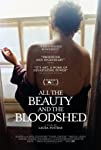Eye For Film >> Movies >> All The Beauty And The Bloodshed (2022) Film Review
All The Beauty And The Bloodshed
Reviewed by: Andrew Robertson

Three brothers, and their families: Arthur; Mortimer; Raymond Sackler. One artist, and their families: Nan Goldin.
Locations various, visited : New York; London; Berlin; Boston; Provincetown; Paris; White Plains.

Dates elided from ongoing works, but: The Ballad Of Sexual Dependency / Ballads Of Sexual Dependency; The Other Side; Memory Lost; Sisters, Saints & Sibyls. PAIN mantlepiece (otherwise 'Untitled').
Elsewhere differently moving images, among them at least: Female Trouble (J. Waters, 1974); Beauty Becomes The Beast (V. Dick, 1979); Empty Suitcases (B. Gordon, 1980); Liberty's Booty (V. Dick, 1980); Variety (B. Gordon, 1983).
In the car the recognisable colour palates and brand furniture of: IKEA; Starbucks; Valium; Oxycontin.
Six chapters, each of a theme, their titles spoken within them: I. Merciless Logic; II. Coin of the Realm; III. The Ballad; IV. Against Our Vanishing; V. Escape Hatch; VI. Sisters.
A soundtrack whose credibility is entirely apposite, with works by and inspired by: The Velvet Underground; Suicide; Screaming Jay Hawkins; Lizzie Mercier-Descloux covering The Crazy World Of Arthur Brown; Kurt Weil.
99 media sources, 74 of those archival. Media mixed without judgement: film by various grades and millimetres; flyers evolving with the slide-show they are kiting for; polaroids, and polarising photographs; what one might call newsreel; typewritten manuscripts; bloodied faces; testimony of torment; witnesses to corporate callousness.
Several stories intertwined. Art and artist, crime and criminal. Survivors and victims. Drawing its title from psychiatric notes in reference to a Rorschach test, All The Beauty And The Bloodshed is as definite as self-reflecting ink on folded paper and as open to interpretation as that mirror of darkness.
The central story, indeed stories, are those of Nan Goldin. Her photography of countercultural New York intersects with those you may know from the Dreaming Walls of the Chelsea Hotel and more. Later life brought fresh struggle with addiction, specifically the epidemic inspiring opioid Oxycontin. Nan Goldin's own work evolving slide-shows, personal photography, an intimacy greater and more naked than make-up and mirrors and tunes and tumescence. At once as ephemeral as an erection and as lasting as love.
Off-screen Laura Poitras. Heard perhaps once, twice. "Can I ask you a question?" a direct quote. Another in a pocketbook (1965) from Conrad's Heart Of Darkness (1899), reproduced here and on screen: "Droll thing life is - that mysterious arrangement of merciless logic for a futile purpose. The most you can hope from it is some knowledge of yourself - that comes too late - a crop of inextinguishable regrets." Paraphrased by a parent; "infinite regrets."
Poitras works with Soundwalk Collective for the first time, actually a surprise given how well integrated the sonic landscapes are to the emotion and support their collaborative compositions add to the proceedings. Goldin herself a soundtrack consultant (that credibility is heightened by shared history, doubtless) but part of her mechanisms, her slide-shows. Not present, but I was minded of it, shared influence (including pop, poppy) of Nick Cave & The Bad Seeds' The Mercy Seat. A corporation that 'never lied' that uses bankruptcy to 'hide in death awhile.' That the Oscar winning film of the same name intersects at 1956 with pharmaceutical history in Leo Sternbach's creation of RO 5-0690, the benzodiazepine that would later be known as Librium, is one of those details that comes from assemblage, the truth of bricolage.
Other conflicts: The notion of art as anything other than political; "a fat cannibal in a black skirt"; the ongoing notion of America's Cold Civil War, entrenched interests of white supremacy and its ostensibly evangelical underpinnings whose stochastic terrors against anything black or queer or otherwise beyond the shifting boundaries of the pale runs gamut from "disco sucks!" rallies to the stigmas attached to the War On Drugs and the capitulation to AIDS whose casualties are still visible in the spaces where life is not.
No sentence long enough. "As long as there are jails", "they should be in them." "It's easy to make your life into stories, it's harder to sustain real memories." [The real] "smells, is dirty, not wrapped up in simple endings." It is not the "banality and deadening grip of suburbia."
There are some things that might cause issues for audiences. Beyond the mechanical, the flashing lights, the sometimes squall, the presence of nudity and violence and the intersections of both, an honesty that is likely to discomfit. There is frank discussion of a variety of harms, and those who have inflicted and suffered them. The intimacies are staggering, the typewritten is as piercing in its gaze as any genital. Goldin's an art world name but plenty of those adjacent to her orbit(s) will be familiar, and many of their fights are far from won. Its length might be off-putting in documentary, but that heft is not wasted, the waits have weight.
I've not even mentioned numbers. There are lots, and while they will draw power from repetition the film does a better job with them. Two stuck. "More than half," and seven. They stuck in part because they were the ones to which history accretes, dirt and despair and delight all. That picture/words exchange rate is made complicated in film because of persistence of vision, and Poitras and Goldin both have very distinct eyes. This is a reflection of a life and a struggle, and not the first of either of them. Tracks through this are numerous, the lists and litanies are just one way of looking. There are more.
One of those seven a collection of statuary, seen at beginning and end, Moses set adrift in a pill bottle. History is what's left. Survivors get to tell stories, but are not unchanged by them. The Temple of Dendur was a Roman construction, donated by the Egyptian government in thanks for contributions to the Aswan Dam. Vast, but far from trunkless, two words remain. 'Private sources.'
Reviewed on: 22 Jan 2023


















